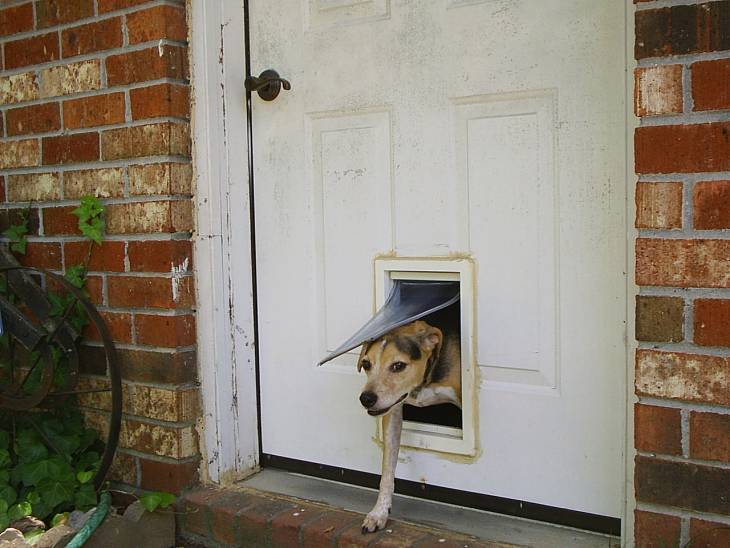Doggie Door Training Tips (Seeing Things Through)
A doggie door can be an essential part of your dog’s potty time. There’s only one hiccup to the process: getting him to use the portal. While your pooch may be reluctant to utilize the contraption at first, this aversion can be overcome with a little training.
Doggie Door Reluctance may be Rooted in Fear
A dog taking to using a doggie door is something that can be a bit more complex than other canine behaviors. Some dogs will figure out how to use the flap and take to utilizing it right away while other ones may appear to not pick up on its mechanics. Sometimes, a dog may not even approach the doggie door at all.
We may be initially inclined to assume this behavior is rooted in a dog’s intelligence and his ability to problem solve. And it may be fair to say that intellect does play a factor in their reluctance, but that doesn’t necessarily mean that you have a dumb dog. Rather, the perceived lack of smarts may be a product of fear or intimidation.
This fear may be due to the dog simply not realizing that freedom stands on the other side of the flap of plastic. It could also be a product of him being scared of the flap smacking them as they pass through the flap. This could stem from your pooch curiously poking his nose through the plastic, and noticing that the flap swings back toward them.
When you work with your pooch to get him to use the doggie door, it’s important that you keep in mind that he may be afraid of walking through the covered hole. This is why you should never push your pooch through as a means to train him. Forcing him to do so may make the behavior feel like a punishment to him, which may end up producing unintended negative ramifications.
So, What’s the Best Way to Go About Getting Him Through the Doggie Door?
Like pretty much anything that is connected to desirable canine behavior, doing some basic training exercises is the key to finding success in getting your dog through the doggie door. At its heart, the training is built on the concepts of simplicity, rewards, and praise. However, because there is a sheath of material involved, it is wise to make sure your pooch gets used to this material making contact with his body during the training process.
The Importance of a Good Doggie Door
While training your dog on how to use the doggie door is of the utmost of importance, it is equally vital to make sure the doggie door that you get is a quality product. There are seemingly tons of options for you to consider, and each one comes with its own set of pluses and minuses. It's important that you conduct thorough research on the door to find the one you think is the best fit not only for your dog but for you as well.
Some of the factors that you should consider directly correlate to the size of your pooch. Others link directly to your budget, as there are some fancy models out there that offer bonus features such as electric door looks that could prohibit strays and various sizes of critters and vermin from infiltrating your home. If you live in a place that is subject to snow or heavy temperature fluctuations, you may consider a doggie door that is built to specifically withhold to such conditions.
The size of the door is particularly noteworthy if you are buying a door for a puppy. If you have a larger breed, you’ll need to make sure to purchase a doggie door based on their projected size. If you think you can save a few bucks by buying a large door for a breed that would be best suited for an extra-large portal, you and your pooch will both experience a wealth of frustration.
A Portal to Freedom for You and the Dog!

Once your dog figures out how to utilize the doggie door, he will be able to experience substantially more freedom. You will also be able to share in this freedom, as a pooch that uses a doggie door translates to an owner that doesn’t have to get up during the wee small hours to let the dog out. For those of us who would prefer to stay asleep at 4 AM or so, this is a huge plus.

